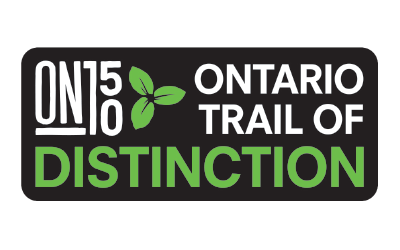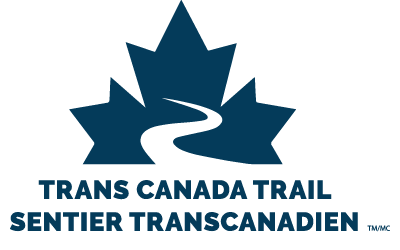FAQ
The Trans Canada Trail (TCT) will be the longest trail in the world. It will stretch 21,000 kilometres from coast to coast to coast and have a presence in all 10 provinces and 3 territories.
Approximately 4000 kilometres - 19% of the proposed trail - in Ontario. The Ontario section consists of an east-west leg joining Quebec and Manitoba. To view a map of the entire national trail, as proposed, visit the TCT website: tctrail.ca.
The Kawartha Trans Canada Trail Association (KTCTA) is a volunteer not-for-profit charitable organization. The KTCTA mandate is the development, operation and promotion of the Trans Canada Trail in the City of Kawartha Lakes.
The County of Peterborough and the Regional Municipality of Durham both have sections of trail officially designated as TCT. The route through the CKL connects these existing sections of TCT. The Kawartha TCT route follows the east to west abandoned CN rail corridor. The route from Durham stretches from Country Rd. 2 (Simcoe St.) through Lindsay and on to Omemee, finally connecting with the Peterborough section at Fowler’s Corners. This 44 km. section of trail winds through rural and urban areas. A link to a map of the trail can be found on the main page of this blog.
The Kawartha Trans Canada Trail Business Plan states that the section of trail heading east from Highway 36 at Lindsay and entering Omemee will be completed by September 2008. The section that runs through the town of Lindsay will be completed in 2009, and the section heading west from Lindsay to Country Rd. 2 at the border of Durham is slated for completion by 2011.
In ever-increasing numbers, Ontarians of all ages are choosing to hike, ski, cycle, horseback ride or snowmobile along trails. The National Post newspaper acknowledged this fact in an article from May 2008, reporting that “Canadians are planning their 2008 vacations around staying fit and healthy eating.”
The trails, then, are providing a venue for recreational activities that are not only pleasurable, but contribute to health and well-being- thus, every investment in trails saves dollars in health care costs.
There are also economic benefits. The average long distance trail user spends $40 per day locally. The 800 kilometre Bruce Trail in Ontario supports 200 direct and 800 indirect jobs within 10 kilometres of the trail. Research from Cycling.
Tourism in Quebec (1999) reports that cyclists spend $105 a day; more than double that of typical tourists at $52 a day. Furthermore, nearly two million bicycles are sold annually in Canada compared to 700,000 automobiles. Over $280 million dollars annually is spent on bikes and accessories. Snowmobilers spend close to $1 billion annually, just in Ontario alone.
Other benefits are less tangible, but important. Trails connect communities to each other, allow users to interact with nature, and offer a peaceful setting for sharing family experiences.
The majority of users will be local residents of the communities connected to the trail including the populations of Lindsay and Peterborough (at least 95,000 individuals combined). In addition, it is expected that tourists will actively seek out opportunities to use the trail.
There are five “core” activities, according to Trans Canada Trail policy: hiking/ walking, cycling, cross-country skiing, horseback riding, and snowmobiling where designated.
Other TCT managers have demonstrated that trails can host, through specific agreements, other linear projects (i.e. water or gas pipelines and fibre optic cables). This shared usage has resulted in significant savings in land assembly for utility companies and can minimize disruption to adjacent land. The trail can also provide access for utility service vehicles and limited access to homes and fields for farmers.
The use of ATVs or motorized dirt bikes will not be permitted on the Kawartha Trans Canada Trail. Any operation of these vehicles on the corridor is illegal.
It may seem inconsistent that one form of motorized transport is allowed, but not others. Permitting snowmobiles on the Trans Canada Trail is an acknowledgment of the significant contributions snowmobiling groups have made to the development, operation, organization and promotion of the TCT system.
There are a number of additional reasons for making a distinction between snowmobiles and other motorized vehicles. These include:
Safety - as trail use increases with the completion of the trail upgrades there will be larger numbers of hikers, cyclists, walkers and runners sharing the trail in the busy spring to fall seasons. The trail will also be used by many schoolchildren as it runs past four schools within the CKL and programs that include trail use will be introduced into the curriculum, where possible. The safety of these users is of paramount concern and motorized traffic would pose significant risk on this narrow trail. KTCTA’s liability insurance does not permit ATV or motorized dirt bike traffic.
Trail Impact - there is also the practical consideration of wear and tear on the trail. Studies prove that ATV use on the trail would more than double the cost of trail maintenance. (With just the five core uses, the cost is $250/km; with ATV use the cost would jump to $535/km. - (Eastern Ontario Trail Alliance).
Incorporation - The KTCTA is a not-for-profit organization incorporated for five cores uses, as identified by the TCT Foundation. Any other use would invalidate our incorporation.
An 85 km stretch of existing rail trail (running to the north and the south of Lindsay) called the Victoria Rail Trail is operated by the municipality and does allow motorized use on certain sections.
Over 100,000 Ontarians have invested in the Trans Canada Trail by purchasing metres of trail and raising a total of approximately $500,000 through individual and private donations. A recent cross-Canada survey demonstrated that 88% believe that the Trans Canada Trail is “good” > “excellent” for Canada. 80% of all Canadians live within 50 km. of the Trans Canada Trail - an estimated 25 million residents. In Ontario, there are 2,500 km. of registered trail (April, 2008).
At a 2004 conference of Federal-Provincial/Territorial Ministers responsible for recreation and sport, the ministers unanimously recognized that physical inactivity poses a major health risk, and that developing strategies to make Canadians more active should be a government priority. As a result of this conference, a framework for action was developed and Ontario created a provincial strategy for active living. The creation of the Provincial Trail Strategy (2005) laid the groundwork for development of a province-wide trail network. Responsibility for its implementation rests with the Ontario Ministry of Health Promotion. The Trans Canada Trail will form the backbone or main trunk of a many-branched trail system linking community to community and opportunity to opportunity.
The Kawartha Trans Canada Trail Association has raised approximately $197,000 for capital development from private donations, the Ontario Trillium Foundation and Legacy Funding (CHEST- Omemee) 2008. It is estimated that over the next three years an additional $300,000 for trail development will be raised through donations, corporate sponsorships, government grants and special events. The City of Kawartha Lakes Council has shown support for the KTCT by passing a motion, in May 2006, endorsing the development of the KTCT.
The Ontario Government – specifically, the Ontario Realty Corporation, owns the land and so the Association is exempt from paying taxes.
Abandoned railway lines offer a broad spectrum of recreational opportunities. Characteristically, these right-of-ways offer the perfect setting for recreational use including relatively mild grades, flat surfaces, natural landscapes, picturesque surroundings, and hundreds of kilometers of primarily unused green-way corridors. These corridors provide a superb opportunity for trail development and pass through many Ontario communities providing easy, safe access to populated rural and urban areas.
No, only the east-west abandoned CN rail trail will be part of the Trans Canada Trail.




